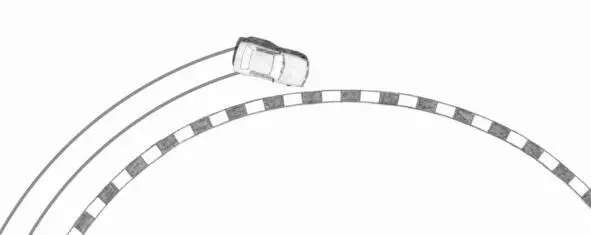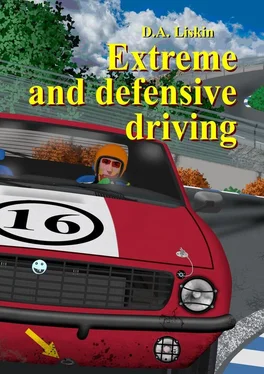Dmitry Liskin - Extreme and defensive driving
Здесь есть возможность читать онлайн «Dmitry Liskin - Extreme and defensive driving» — ознакомительный отрывок электронной книги совершенно бесплатно, а после прочтения отрывка купить полную версию. В некоторых случаях можно слушать аудио, скачать через торрент в формате fb2 и присутствует краткое содержание. ISBN: , Жанр: Спорт, на английском языке. Описание произведения, (предисловие) а так же отзывы посетителей доступны на портале библиотеки ЛибКат.
- Название:Extreme and defensive driving
- Автор:
- Жанр:
- Год:неизвестен
- ISBN:9785005372321
- Рейтинг книги:4 / 5. Голосов: 1
-
Избранное:Добавить в избранное
- Отзывы:
-
Ваша оценка:
- 80
- 1
- 2
- 3
- 4
- 5
Extreme and defensive driving: краткое содержание, описание и аннотация
Предлагаем к чтению аннотацию, описание, краткое содержание или предисловие (зависит от того, что написал сам автор книги «Extreme and defensive driving»). Если вы не нашли необходимую информацию о книге — напишите в комментариях, мы постараемся отыскать её.
Extreme and defensive driving — читать онлайн ознакомительный отрывок
Ниже представлен текст книги, разбитый по страницам. Система сохранения места последней прочитанной страницы, позволяет с удобством читать онлайн бесплатно книгу «Extreme and defensive driving», без необходимости каждый раз заново искать на чём Вы остановились. Поставьте закладку, и сможете в любой момент перейти на страницу, на которой закончили чтение.
Интервал:
Закладка:
Thus, the same time pressing the throttle and brake pedals on a rear-drive car creates understeer and allows you to get out of drift. In the future this method of fighting with drift on a rear-wheel-drive car will be called a defensive “throttle+brake” technique. As a rule, at drift angle of approximately 45 degrees (the angle must be checked for each car) and more “throttle+brake” technique does not work, since traction on rear loaded wheel causes car to turn around.
It is important to understand, that “throttle+brake” technique forced a car to move straight. When performing the technique drifting stops, the machine continues to move in a straight line in the same direction, in which it was moving before performance the technique. Therefore it is necessary to calculate trajectory and duration of “throttle+brake” pulse. If a driver has reacted to drift in time, a short impact on the brake pedal and steering correction may be enough. Note, that “throttle+brake” technique allows you to get out of drift, without turning the front wheels.
Since the front wheels are locked, it does not matter, which way they are turned. But to successfully take control at the end of the technique, when the front wheels are in locked condition, you should put the steering wheel straight. There are two reasons for this:
• the suspension geometry is such, that when the front wheels are turned by the steering wheel, the front of car come down; the straighten wheels will lift the front of car back; the greater front clearance – the lower steerability;
• if the front wheels are set in the straight position, car will remain neutral behavior after releasing the throttle and brake pedals (the car’s behavior will not change).
At the end of “throttle+brake” technique it is enough to align trajectory with a corrective steering. If it is necessary to avoid an obstacle or bend trajectory because of other reasons, you should turn the front wheels previously, during perform the technique, when the front wheels are locked.
The torque transmitted to rear loaded wheel depends on engine torque. If engine torque is high enough, efficiency of “throttle+brake” technique may fall: when together pressed the throttle and brake pedals the rear wheels start to skid. In this case to exclude skidding of rear loaded wheel, you should limit effort on the throttle pedal during performance the technique.
For “throttle+brake” technique to work on a rear-wheel drive car, the brake system must be properly configured. It is necessary, that both front wheels are locked when the brake pedal is fully pressed both when moving forward in a straight line, and when passing corners to the left and right or when the car is in a drift. In addition, the braking effort on the rear wheels should not be too high, and engine torque should not be too low. If the rear wheels will be locked, the engine will stall.
Requirements for successful exit from a drift on a rear-wheel-drive car with help of “throttle+brake” technique
• both front wheels must lock when the car is in a drift;
• the rear wheels must not be locked;
• skid of rear loaded wheel should not occur;
• differential friction should not be too high;
• drift angle should not be greater, than about 45 degrees.
The last two requirements are very conditional. Performing of the technique may differ on different machines, so you need to perform concrete tests. It is not difficult to test “throttle+brake” technique: you just need to provoke a drift and press the throttle and brake pedals.
It was not said, but was obvious, that to perform the above-listed techniques an anti-lock system should not be installed on car, which prevents the wheels from locking by the brake system. In the presence of an anti-lock system it is impossible to perform defensive “throttle+brake” technique on a rear-wheel-drive car.
Recommendations for driving a car in a drift
• while driving car in a drift, your hands should be relaxed, you do not need to hold the steering wheel with a death grip;
• while drift turn your head and direct your gaze along the direction of movement of car, keep the hood in the background, so you will definitely feel angle of drift;
• when fighting with a deep drift direct your gaze forward, through the windshield – this will help you maintain your orientation in space.
Notes on performing of “throttle+brake” defensive technique on a rear-wheel-drive car
• during perform the technique you should to straighten the front wheels or turn them by the steering wheel in the direction, in which you want to continue move at the end of the technique;
• if the engine torque is quite high and the rear wheels start to skid when performing the technique, you need to limit effort on the throttle pedal: the traction on the rear axle is only needed to unload the front;
• the duration of the technique is controlled according to trajectory of movement.
Exercise 1. Work out the skills of getting out from drift with help of steering. Actions will vary depending on the type of drive: on front-wheel-drive type it is necessary to increase the traction and to turn the steer against direction of drift, on rear-wheel-drive – you need to let go of the throttle pedal, press the clutch pedal and direct the front wheels in the direction of motion (you should to rotate the steer against the direction of drift until desired position of the front wheels).
Be careful! When exiting a drift on a rear-wheel-drive car there should not be a long pause after turning the steer against direction of drift. Otherwise there may be a response from the car, and there will be a rhythmic drift. As soon as drift has started to stop, you need to immediately return the steer to the “straight” position.
Exercise 2. Create oversteer on a front-wheel-drive car at the entrance to a long corner (arc) with help of “throttle+brake” technique. Repeating the training, try to gradually increase speed of entering the corner.
Exercise 3. On a rear-wheel-drive car, press the throttle pedal at the exit of a corner, to trigger drift. Without releasing the throttle pedal, sharply hit the brake pedal with your left foot, to eliminate the drift. After stopping drifting release the pedals and restore trajectory by the steer motions. Repeating the exercise, determine angle of drift, more than which the technique “throttle+brake” does not work. Limit effort on the throttle pedal if there is a skid of rear loaded wheel and efficiency of “throttle+brake” technique decreases.
Remember that on a front-wheel-drive car one time pressed the throttle and brake pedals increases steerability, while on a rear-wheel-drive car – they decrease it. If this is the first time when you are perform the technique, limit speed and provide braking distance enough in all possible directions.
Exercise 4. On rear-wheel-drive or all-wheel-drive cars, prepared for drift, the exercises “ring”, “eight” and the passage of a hairpin with drift of the rear axle will be useful. Rings should be selected in different diameters to work out different speed modes.

We press the throttle pedal with pulses, as if groping for optimal traction, and at the same time we steer. Our goal will be a stable retention of trajectory radius and minimal fluctuations in drift angle.
Exercise 5. Go through a 180-degree turn (hairpin) with the rear axle drifting. At entrance to the corner provoke drift by rocking, handbraking or including a low gear.
Читать дальшеИнтервал:
Закладка:
Похожие книги на «Extreme and defensive driving»
Представляем Вашему вниманию похожие книги на «Extreme and defensive driving» списком для выбора. Мы отобрали схожую по названию и смыслу литературу в надежде предоставить читателям больше вариантов отыскать новые, интересные, ещё непрочитанные произведения.
Обсуждение, отзывы о книге «Extreme and defensive driving» и просто собственные мнения читателей. Оставьте ваши комментарии, напишите, что Вы думаете о произведении, его смысле или главных героях. Укажите что конкретно понравилось, а что нет, и почему Вы так считаете.












